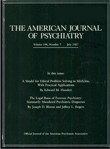Side Effects of Short-Term 10,000-Lux Light Therapy
Abstract
OBJECTIVE: Previous reports of side effects from light therapy were mostly based on administration of 2,500-lux treatments. It has become common practice to use brighter, 10,000-lux exposure when treating seasonal affective disorder. The authors studied side effects produced by short-term 10,000-lux light therapy. METHOD: Seventy subjects with seasonal affective disorder who underwent brief 10,000-lux light therapy were asked to report side effects. RESULTS: Of the 70 subjects, 32 (45.7%) experienced side effects, and nine (12.9%) reported two or more apiece. Headaches and eye or vision problems were the most common. Almost all were mild, were transient, and did not interfere with treatment. CONCLUSIONS: Short-term 10,000-lux light therapy often produces side effects early in treatment. These are not serious or prolonged, however, confirming findings from earlier studies that used dimmer light. (Am J Psychiatry 1998; 155:293–294)



